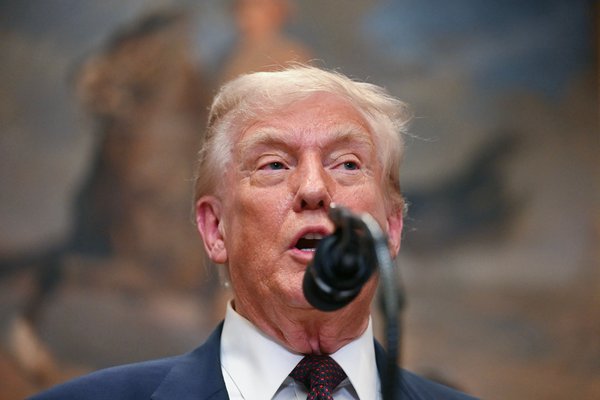The July jobs report wasn’t just underwhelming. It flipped the story of this year on its head.
Payrolls grew by a meager 73,000 jobs, according to Bureau of Labor Statistics data released Friday, far below the roughly 110,000 anticipated. Adding insult to injury, May and June numbers were revised down by a staggering 258,000 jobs — the biggest two-month revision in five years — leaving the labor market’s momentum looking weaker than it has all year. That means payroll growth has averaged just 35,000 jobs per month over the last three months, once revisions are accounted for, the weakest stretch since early in the COVID-19 pandemic. And it suggests that any job growth in the two earlier reports may have been nothing more than a mirage.
Meanwhile, the unemployment rate edged up to 4.2% (the highest level since October 2021), and the overall workforce shrunk, showing that joblessness rose even as fewer people were seeking work — a rare red flag.
The labor market isn’t falling off a cliff, but it’s drifting into dangerous territory.
Stocks fell sharply Friday after both the jobs report and President Donald Trump’s announcement late Thursday of a parade of tariffs on dozens of countries that will take effect next week, threatening to upend global commerce and trigger price increases for U.S. consumers. “The Economy is BOOMING under ‘TRUMP,’” the president insisted on Truth Social.
Trump wasted no time in casting blame for the bad jobs numbers, first targeting a familiar foe in Federal Reserve Chair Powell before turning to a new target: The president said Friday afternoon that he had ordered the firing of Bureau of Labor Statistics Commissioner Erika McEntarfer, an unprecedented political intrusion into the traditionally nonpartisan, bureaucratic compiling of economic data — and one that risks only spooking markets further. Without offering any evidence, Trump accused her of manipulating jobs data for political purposes and alleged that the jobs report was “faked.”
There is no evidence of political meddling in the jobs data, and the BLS, considered the gold standard for labor data, has long used consistent, transparent methodologies to revise data as more accurate information becomes available.
Analysts called the president’s claims baseless. Steven Blitz, the chief U.S. economist at Lombard, told The Financial Times, “Firing the head of the BLS with the aim of making economic statistics bend to the will of the president is not something that befits a first-world economy.” Other analysts have noted that Trump’s attacks risk undermining public trust in one of the government’s most respected statistical agencies.
Markets regained some earlier losses but remained sharply off for the day. The Dow Jones Industrial Average was down more than 550 points, or about 1.2%, shortly before markets closed. The S&P 500 was off 1.6%, breaking below its 20-day moving average. And the tech-heavy Nasdaq was down 2.2%.
There were “no redeeming qualities” in the jobs data, Jefferies analysts said in a report early Friday. “Surely, Chair Powell wishes he had these numbers 48 hours ago,” the analysts said, referring to the central bank’s decision earlier this week to keep interest rates steady. “A much more downbeat view on the health of the labor market would have made a more dovish message easier to deliver with confidence.”
Ali Jaffery at CIBC Capital Markets had a blunt first reaction, according to Bloomberg: “Ouch.”
Before the report, traders were only giving the Fed about coin‑flip odds on a September move. Now their bets fully embrace a pivot. Jefferies believes the Fed remains on track for a September cut, followed by two more in November and December.
The two‑year Treasury yield plunged 22 basis points to around 3.74%, reflecting a fierce bond market reaction to the weak jobs data. Markets didn’t stop there: Interest-rate futures showed an 88% chance of a Fed rate cut in September, up from roughly 40% the day before, and swaps were pricing in about 18 basis points of easing by September.
Chris Zaccarelli, chief investment officer at Northlight Asset Management, said the market’s first move was predictable: Rates dropped and stock futures slipped. Normally, the headline number would be shrugged off in favor of the three-month average — but with a 258,000-job downward revision to May and June, Zaccarelli said, both interest rates dropping and stock futures giving up ground “are in play today.” Stocks “will probably move past this particular report” and keep climbing later this month, he said, but between new tariffs and fresh evidence that the job market is softening, “today could be an ugly day” on Wall Street.
While traders are leaning toward a rate-cut narrative, the Fed has yet to commit. Powell, speaking earlier this week, said the labor market still looked “solid” and reiterated that officials would remain data-driven. Powell may still describe the labor market as “in balance,” but market dynamics show a different drama. Two Fed governors dissented in favor of rate cuts at the July meeting — the first such split in over 30 years. Powell emphasized that the unemployment rate is his lodestar metric, and with it inching higher despite a shrinking labor force, policy patience may be wearing thin.
“Just two days after the conclusion of this month’s Fed meeting, suddenly the dual mandate is back on the table,” Zaccarelli wrote. “With this morning’s payroll miss – and the downward revisions that came with it – the Fed will again need to balance a slowing job market with inflation which isn’t slowing fast enough.”
Charlie Ripley, senior investment strategist at Allianz Investment Management, struck a similar note: “Overall, today’s data signals labor market conditions continue to cool. And while the softer conditions don’t warrant a warning signal for investors, it should put market participants—including the Fed—on notice that economic conditions are shifting.”
Soft hiring, hard exit
Despite headlines, wage growth wasn’t terrible — it rose 0.3%, in line with forecasts, bringing the year-over-year increase to 3.9%. That’s still outpacing inflation, which gives workers some breathing room, but paychecks alone won’t offset the broader softening. That silver lining is nearly invisible next to structural weakness.
One of the most concerning signals isn’t what’s happening, but who’s leaving. July marked the second straight month of labor force contraction. Participation dipped again (to 62.2%), and the number of people not in the labor force but still wanting a job has jumped by over half a million in the past year. The household survey told a starker story: Employment fell by 260,000, while unemployment rose by 221,000. The labor force dropped by 38,000, bringing participation to its lowest level since November 2022.
In other words, people aren’t just struggling to get hired, they’re giving up. That the unemployment rate rose even as more workers exited the job market underscores the slowdown. And it wasn’t just the establishment survey that raised eyebrows: the household survey, a broader look at employment, showed a net loss of jobs for the month.
The jobs that did appear in July came almost entirely from health care and social assistance. Together, those sectors added 73,000 jobs. Finance added 15,000, while retail trade and warehousing contributed 19,000. Most other sectors — construction, manufacturing, retail, transportation — were flat or losing steam. Manufacturing shed 11,000 jobs, and professional and business services fell by 14,000. Federal government payrolls fell by 12,000, continuing a months-long trend as agencies tighten belts amid budget pressure. Leisure and hospitality, once a post-pandemic growth engine, added just 5,000 jobs.
The broader context elevates the alarm. Labor demand is shedding strength: JOLTS data shows job openings fell by 275,000 in June, signaling hiring pullback across key industries such as restaurants and hospitality. Meanwhile, the foreign-born workforce declined by over 500,000 last month and is down by 1.7 million since March — signs that tighter immigration policy may be exacerbating labor shortages. That could drive up wages in the short term but make it harder for businesses to meet demand.
Fresh tariff action took effect Friday, as it marked Trump’s August 1 deadline for countries to either strike trade agreements or face steep new duties. The president announced tariffs on nearly 70 countries. Canadian goods were hit immediately, with levies jumping from 25% to 35%, while broader punitive tariffs — up to 50% for Brazil, 25% for India, and 20% for Taiwan — are set to kick in August 7. The sweeping move pushed global markets lower and compounded the gloom surrounding the weak jobs report, adding urgency to concerns that firms are pulling back on hiring amid rising trade risk.
That convergence of softer hiring, rising jobless claims, and political uncertainty creates two real paths for the Fed. The first: a gloomy one where a weakening labor market pushes officials to deliver relief via rate cuts. The second: a more benign path where activity holds, inflation gradually cools, and the Fed preempts overtightening. The July report didn’t declare which route we’re on, but it certainly tilted expectations toward the former.

